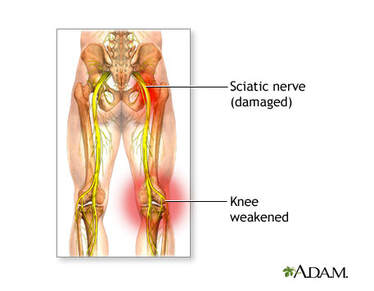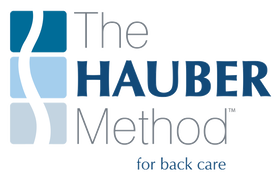Solutions for Sciatic Pain
 Click the image to go to Medlineplus and read more about the sciatic nerve.
Click the image to go to Medlineplus and read more about the sciatic nerve.
Sciatica is one of the most common causes of back and hip pain.
The problem
Sciatica is frequently caused when a lumbar disk herniation from L5, S1, or S2 presses into the sciatic nerve, which runs from the low back through the glutes and down the back of the leg.
It can cause pain and weakness all the way into the foot.
Because of its position and its size, the sciatic nerve has more opportunities for strain, inflammation, or impingement than any other nerve in the body.
Herniations in the sacrolumbar disks might be the most common cause, but oftentimes a true reason for sciatic nerve pain can't be parsed out due to its other possible causes.
Another frequent cause of sciatic pain is inflammation of the piriformis muscle, which exits the sacral area through the same space where the sciatic nerve lives and attaches to the top of the femur. The so-called "sciatic notch" isn't big enough for both the nerve and an inflamed, spasming, or shortened piriformis muscle. So damage to or misuse of this important muscle in the hip can really wreak havoc on the poor sciatic nerve, sending pain and weakness down the leg.
The problem
Sciatica is frequently caused when a lumbar disk herniation from L5, S1, or S2 presses into the sciatic nerve, which runs from the low back through the glutes and down the back of the leg.
It can cause pain and weakness all the way into the foot.
Because of its position and its size, the sciatic nerve has more opportunities for strain, inflammation, or impingement than any other nerve in the body.
Herniations in the sacrolumbar disks might be the most common cause, but oftentimes a true reason for sciatic nerve pain can't be parsed out due to its other possible causes.
Another frequent cause of sciatic pain is inflammation of the piriformis muscle, which exits the sacral area through the same space where the sciatic nerve lives and attaches to the top of the femur. The so-called "sciatic notch" isn't big enough for both the nerve and an inflamed, spasming, or shortened piriformis muscle. So damage to or misuse of this important muscle in the hip can really wreak havoc on the poor sciatic nerve, sending pain and weakness down the leg.
The solution
Any time herniated disks are pressing into the sciatic nerve, or when the piriformis is not stretched and properly trained, the best line of defense is going to be:
Any time herniated disks are pressing into the sciatic nerve, or when the piriformis is not stretched and properly trained, the best line of defense is going to be:
- strengthening the deep core and back muscles to lift weight upward against gravity and out of the lumbar spine, taking pressure out of the sacrum and hip joint and alleviating compression of the disks that may be hitting the nerve, and
- stretching the tight muscles in the lower body (especially that piriformis, but also the iliopsoas and glute medius, along with the calves) that are pulling our spine into poor posture, or
- using trigger point, myofascial release, or professional deep tissue massage (see this article on effective complementary therapies) to target the tight piriformis and its attending fascia, and then following it with proper stretches.
The Hauber Method™, of course, provides exactly the stretches and exercises you need to relieve sciatica and stop the radiating pain of piriformis syndrome.
The crossover hip stretch, one of the first movements you learn in Hauber Method™ session 1, is a good start, as it begins to access the piriformis muscle. Once your core is stronger, you’ll learn two additional stretches that pinpoint the piriformis precisely and can make a huge difference in your experience of sciatic pain.
Remember, without adding that crucial core strength and proper posture to your training and treatment programs, you will not relieve sciatica or piriformis syndrome. Stretching the hip alone is never enough!
You need strength to keep your body from falling into bad posture habits and creating the problem in your hip all over again.
In the Hauber Method™ series, I guide you through exactly what you need to do to end sciatic pain.
The crossover hip stretch, one of the first movements you learn in Hauber Method™ session 1, is a good start, as it begins to access the piriformis muscle. Once your core is stronger, you’ll learn two additional stretches that pinpoint the piriformis precisely and can make a huge difference in your experience of sciatic pain.
Remember, without adding that crucial core strength and proper posture to your training and treatment programs, you will not relieve sciatica or piriformis syndrome. Stretching the hip alone is never enough!
You need strength to keep your body from falling into bad posture habits and creating the problem in your hip all over again.
In the Hauber Method™ series, I guide you through exactly what you need to do to end sciatic pain.
"Solutions for Sciatic Pain" by Sara Hauber.
Originally published as "Solutions for Sciatica" in 2014; updated and republished December 7, 2019.
Originally published as "Solutions for Sciatica" in 2014; updated and republished December 7, 2019.
Ready to finally stop the pain and tension in your hips, back, and legs?
Or feel like you need more information about how the body can heal without surgery or pain meds?
